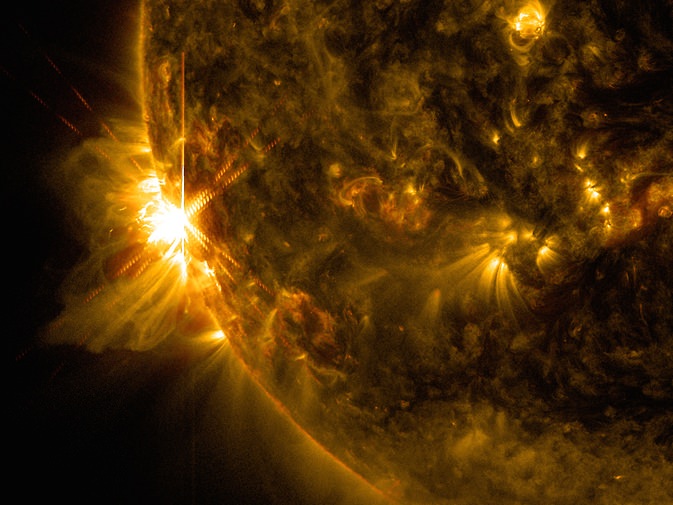In only a little over an hour, the Sun released
two
X-class solar flares today. The first occurred at 11:42 UTC (7:42 a.m. EDT) and the second blasted out at 12:52 UTC (8:52 a.m. EDT) on June 10, 2014. According to
SpaceWeather.com
, forecasters were expecting an X-class flare today, but not two...and certainly not from region of the Sun where the flares originated. Solar scientists have been keeping an eye on sunspot regions AR2080 and AR2085, especially since they are now directly facing Earth, and those two sunspots have 'delta-class' magnetic fields that harbor energy for X-flares.
But the active region on the Sun that actually produced the flares was AR2087, which just appeared "around the corner" on the southeastern limb of the Sun. The first flare was a X2.2-flare and the second was an X1.5-flare.
See the image of #2 below from the Solar Dynamics Observatory:
[caption id="attachment_112472" align="aligncenter" width="580"]
The second X-class flare of June 10, 2014, appears as a bright flash on the left side of this image from NASA's Solar Dynamics Observatory. This image shows light in the 193-angstrom wavelength, which is typically colorized in yellow. It was captured at 8:55 a.m EDT, just after the flare peaked. Image Credit: NASA/SDO.[/caption]
Solar flares are explosions on the Sun that release energy, light and high speed particles into space, and the biggest flares are known as X-class.
Here's the view from @ESA / @NASA SOHO/LASCO C2 of the CME resulting from the big X-class flare earlier today pic.twitter.com/KYU2uHwdxO — Sungrazer Comets (@SungrazerComets)
Here are some recent astrophotos of the Sun taken by members of
Universe Today's Flickr group
:
[caption id="attachment_112471" align="aligncenter" width="580"]
The Sun in white light on June 10, 2014. Taken with a William Optics 70mm refractor fitted with a Thousand Oaks solar filter, 2 x Barlow and Canon 1100D. Credit and copyright: Mary Spicer. [/caption]
[caption id="attachment_112470" align="aligncenter" width="580"]
The full solar disk in hydrogen alpha on June 10, 2014. Credit and copyright: John Brady. [/caption]
[caption id="attachment_112473" align="aligncenter" width="580"]
A look at the Sun from the UK on June 9, 2014. Prime focus single shot in whitelight, Canon 600D attached to Maksutov 127mm telescope fitted with homemade Baader Solarfilm filter. Credit and copyright: Sarah and Simon Fisher. [/caption]
Solar flares are classified on a system that divides solar flares according to their strength. The smallest ones are A-class (near background levels), followed by B, C, M and X. Similar to the Richter scale for earthquakes, each letter represents a 10-fold increase in energy output. So an X is ten times an M and 100 times a C. Within each letter class there is a finer scale from 1 to 9.
Here's NASA's video guide to X-Class flares:
NASA says these flares are often associated with solar magnetic storms known as coronal mass ejections (CMEs). The number of solar flares increases approximately every 11 years. Watch this video below about why solar scientists think the solar maximum is happening now:
Read more on today's flares from NASA.
 Universe Today
Universe Today
